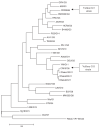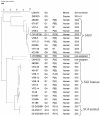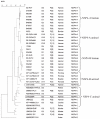Molecular characterization of G11P[25] and G3P[3] human rotavirus strains associated with asymptomatic infection in South India
- PMID: 17854037
- PMCID: PMC2465802
- DOI: 10.1002/jmv.20988
Molecular characterization of G11P[25] and G3P[3] human rotavirus strains associated with asymptomatic infection in South India
Abstract
Rotaviruses are the major etiological agents of diarrhea in children less than 5 years of age. Two unusual rotavirus strains not previously reported in India, G11P[25] (CRI 10795) and G3P[3] (CRI 33594) were isolated from faecal samples of asymptomatic children in India. The strains were characterized by sequence analysis of the genes encoding the VP7, VP4, VP6, and NSP4. The G11P[25] strain was closely related to the human G11P[25] strains from Bangladesh (with 98% identity at the nucleotide [nt] level and the amino acid [aa] level for the VP7 gene and 96% identity at the nt and 98% at the aa level for the VP4 gene). The G3P[3] strain was found to be related to a G3P[3] strain isolated in Thailand (CMH222; 88% identity at the nt level and 97% at aa level for the VP7 gene and 84% identity at the nt level and 90% at the aa level for the VP4 gene). Phylogenetic analysis of the VP6 and the NSP4 genes revealed that the Vellore G11P[25] strain was of VP6 subgroup II and NSP4 genotype B. The G3P[3] strain was identified as NSP4 genotype C and the VP6 gene showed 97% identity at the deduced amino acid level with strain CMH222 (Thailand) strain but did not cluster with sequences of SGI, SGII, SGI+II or SG-nonI/nonII. Both strains had gene segments of animal rotavirus origin suggesting inter-species transmission of rotavirus, and in the case of G11P[25] possibly underwent reassortment subsequently with human strains resulting in an animal-human hybrid strain.
(c) 2007 Wiley-Liss, Inc.
Figures




References
-
- Banerjee I, Ramani S, Primrose B, Moses P, Iturriza-Gomara M, Gray JJ, Jaffar S, Monica B, Muliyil JP, Brown DW, Estes MK, Kang G. Comparative study of the epidemiology of rotavirus in children from a community-based birth cohort and a hospital in South India. J Clin Microbiol. 2006;44:2468–2474. - PMC - PubMed
-
- Banerjee I, Gladstone BP, Le Fevre AM, Ramani S, Iturriza-Gomara M, Gray JJ, Brown DW, Estes MK, Muliyil JP, Jaffar S, Kang G. Neonatal infection with G10P[11] rotavirus did not confer protection against subsequent rotavirus infection in a community cohort in Vellore, South India. J Infect Dis. 2007;195:625–632. - PMC - PubMed
-
- Chan-It W, Khamrin P, Saekhow P, Pantip C, Thongprachum A, Peerakome S, Ushijima H, Maneekarn N. Molecular characterization of VP4 and VP7 genes of nontypeable strains identifies a novel P[28] genotype in porcine rotaviruses. J Clin Microbiol. 2007 - PubMed
-
- Ciarlet M, Liprandi F, Conner ME, Estes MK. Species specificity and interspecies relatedness of NSP4 genetic groups by comparative NSP4 sequence analyses of animal rotaviruses. Arch Virol. 2000;145:371–383. - PubMed
Publication types
MeSH terms
Substances
Associated data
- Actions
- Actions
- Actions
- Actions
- Actions
- Actions
- Actions
- Actions
Grants and funding
LinkOut - more resources
Full Text Sources
Medical
Research Materials

